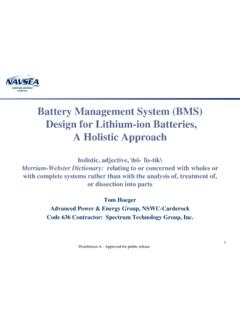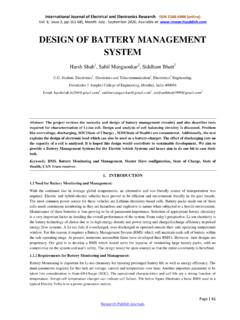Transcription of Design and Analysis of a Battery for a Formula Electric Car
1 Design and Analysis of a Battery for a Formula Electric Car by Samuel Reineman Submitted to the Department of Mechanical Engineering in Partial Fulfillment of the Requirements for the Degree of Bachelor of Science in Mechanical Engineering ARCHrE;. at the Aa f YjT7! Massachusetts Institute of Technology June 2013. @ 2013 Massachusetts Institute of Technology. All rights reserved. Signature of Author: Department of Mechanical Engineering May 17, 2013. Certified by: Anette Hosoi Professor of Mechanical Engineering Thesis Supervisor Accepted by: Anette Hosoi Professor of Mechanical Engineering Undergraduate Officer 2. Design and Analysis of a Battery for a Formula Electric Car by Samuel Reineman Submitted to the Department of Mechanical Engineering on May 17, 2013 in Partial Fulfillment of the Requirements for the Degree of Bachelor of Science in Mechanical Engineering ABSTRACT.
2 The purpose of this paper is to present the philosophy and methodology behind the Design of the Battery pack for MITs 2013 Formula SAE Electric racecar. Functional requirements are established for the pack. An overview of cell chemistry, pack size and configuration selection process to meet these requirements is given. Next, the mechanical and electrical Design and Analysis of the major pack components is discussed. Finally, a transient thermal model of the pack is established to guide Design choices about cooling. Thesis Supervisor: Anette Hosoi Tile: Professor of Mechanical Engineering 3. 4. Table of Contents Overview of the FSAE Electric Competition .. 8. Introduction to the Tractive system .. 8. Functional Requirements .. 9. Safety .. 10. Power Density vs Energy Density .. 11. Track 13. Accumulator Design .. 14. Chemistry Selection .. 14. Pack Sizing.
3 15. Tab 18. Clamping Plate .. 19. Clamping 20. Clamping 21. Pack architecture .. 22. Cell Separation .. 23. Endplate Design .. 24. Battery Management system .. 25. Electrical Layout .. 26. Mechanical Layout .. 27. 5. Thermal Analysis .. 28. Heat Generation ..29. Adiabatic Model ..30. Cooling Model ..32. Results ..34. Conclusion ..38. Appendix ..40. Natural Convection .. 40. References ..41. 6. List of Figures: Figure : Block diagram of the Tractive system .. 9. Figure : Power density vs Energy Density .. 12. Figure : Simulated current draw over one lap of the endurance race .. 14. Figure : A123 20Ah Pouch Cell Discharge Profile at 17. Figure : Tab Clamping Overview .. 19. Figure : FEA of the Clamping Plate .. 20. Figure : Exaggerated Wedge Displacement Under Load .. 21. Figure : FEA of the Clamping Bar Under Load .. 22. Figure : Full 28s Module 23. Figure : Cross Section Showing Cell Separation.
4 24. Figure : Endplate FEA under 20g Crash Loading 25. Figure : BMS Electrical Block 27. Figure : 28s Module with BMS Board .. 28. Figure : Basic Cell Model .. 29. Figure : Test Setup for Measuring Internal Resistance .. 30. Figure : Transient Pack Temperature over an Endurance Race .. 35. Figure : Pack Temperature Rise With and Without Heat Spreaders .. 36. Figure : Fan Cooling Performance 37. 7. Overview of the FSAE Electric Competition Formula SAE is an international, intercollegiate Design competition focused around the Design and fabrication of a small-scale Formula style race car. Several different versions of the competition exist, ranging from gas powered ICE cars to hybrid to full Electric cars. In all of the competitions, students build cars guided by a set of rules published each year by the Society of Automotive Engineers [1]. The rules primarily focus on safety; the vast majority of Design decisions are carried out by the participating teams, resulting in a wide variety of cars at the final competition, which are then raced and judged based on performance, Design , and a variety of other metrics.
5 MIT Motorsports, the student team at MIT which participates in the Formula SAE. competition, switched this year from the gas competition (FSAE) to the Electric competition (FSAE Electric ); this change has introduced a host of new engineering challenges in the Design of a safe and reliable fully Electric powertrain. Introduction to the Tractive system MIT's 2013 car is built around the tractive system . A block diagram overview of the system , created by Brian Sennett (MIT '13), is presented in Figure In general, power is provided by the batteries (more generically referred to as an accumulator) to two motor controllers which take inputs from the vehicle controller to torque-control two independent motors, each powering one of the rear wheels of the car. A series of safety devices compose a shutdown circuit, which has the ability to open the Accumulator Isolation Relays (AIRs).
6 Separating the batteries from the car in case of an emergency. The accumulator itself is 8. composed of A123 20Ah pouch cells arranged in custom built modules held inside a kevlar composite accumulator housing, along with a variety of safety and monitoring circuits. Figure : Block diagram of the Tractive system [2]. Functional Requirements Functional requirements for the tractive system were established based on the events the car participates in during competition. These events are divided into two groups: static events which cover the Design of the car, and dynamic events, which cover the performance. Our functional requirements were primarily drawn from desire to perform well over the whole range of dynamic events, combined with limitations placed on the car by the rules. The dynamic events involve an acceleration event (fastest time to travel 100m), a skid-pad event (car's ability to corner in a figure-8), autocross (fastest time for a 1km long racecourse, tests acceleration, handling, and driving skill), and endurance (20 laps of the 1km long autocross course).
7 Of these events, the endurance race and the acceleration both test the performance of 9. the accumulator (skid-pad and autocross are more concerned with the general handling of the car, which while it of course involves accumulator performance, is greatly influenced by a large number of other factors). In order to perform optimally in acceleration, the car must be able to draw the maximum amount of power allowed by the rules from the accumulator (85kW). In order to perform optimally in endurance (or perform at all, for that matter), the accumulator must contain enough energy to power the car over the 20km course. Additional functional requirements are derived by looking towards the Design competition, rules, and ease of assembly of the pack. To summarize the requirements we developed, in order of importance: Functional Requirements of Accumulator: 1. Supply the maximum allowable power at the desired voltage to the motors 2.
8 Store enough energy to power the car for the entire endurance event 3. Comply with all the safety regulations laid out in the rules 4. Not overheat during any event under reasonable conditions 5. Not add significant weight above that of the bare cells 6. Able to be disassembled quickly and non-destructively After establishing these functional requirements, all Design work on the accumulator was undertaken to address specific items in this list. Safety As the Battery pack operates at 300 Volts and can output over 1000 Amps during a short circuit condition, resulting in instantaneous power dumps on the order of MW, pack safety is of utmost importance. A series of safety devices and sensors, designed in accordance with the rules, were integrated into the pack. The primary safety device is the Shutdown Circuit, designed by Brian Sennett (MIT '13). This takes input from a variety of sensors, and if activated, will open two Kilovac EV200 relays mounted at both poles of the accumulator.
9 These 10. contactors are capable of breaking 2000 Amps at 600V; they are the main panic switch for the car in case of an emergency. The positive pole of the pack is fitted with a fast-acting semi- conductor fuse that would blow instantaneously in the case of a full pack short. The fuse is sized so that it is the first of any element to blow during an overcurrent event. The fuse is just a backup, however. The Battery Management system constantly monitors the state of the accumulator, including the current, and can tell the shutdown circuit to open the relays in case of an emergency. These devices, along with a variety of others described in the rules, make sure the accumulator is only operating under safe conditions. In addition to the physical safety devices, the team has put a lot of work into the way we think about high voltage safety. Every conceivable failure mode of the pack (and the entire car, for that matter) has been documented in a Failure Mode Effect Analysis document, as dictated by the rules, along with the proper responses to those failures.
10 In order to work in close proximity to the accumulators or car when the accumulators are installed, team members must first take and pass the same high voltage safety course and test as Tesla powertrain engineers must. Part of this course is a description of the proper safety equipment needed to work on the accumulator - our team has several sets of the correct equipment, and this equipment must be worn while working on the accumulator. It is our hope that a combination of good safety Design and good safety consciousness will prevent any hazardous situations long before they become dangerous. Power Density vs. Energy Density In the world of energy storage, there is an inherent tradeoff between specific power and specific energy, or in other words, how much power a cell can output for a given weight, which correlates to an Electric Vehicle's (EV's) acceleration, and how much total energy it can store, which correlates to an EV's range.
















